Land flatworms are invading the West Indies
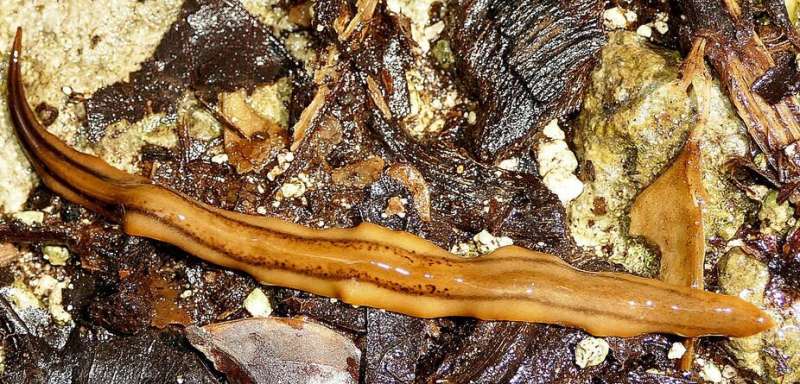
In 2013, an inhabitant of Cagnes-sur-Mer, France, found a in his garden and had the good idea to send the photograph to a network of naturalists. We then launched a in France to learn more—and we were not disappointed. More than 10 species of land flatworms from elsewhere are now reported in metropolitan France, including a giant species 30 centimeters long and a species that is now found in more than 70% of France's departments.
An unexpected result was receiving photographs from the overseas French departments, particularly the West Indies. With a tropical climate, the West Indies can host species that could not survive in mainland France. We often receive new accounts of and this is an initial report.
The giant "hammerhead worm," Bipalium kewense
Let's start with the big one. The "hammerhead worm," Bipalium kewense, is indeed a giant: 30 centimeters—longer than your shoe, even if you wear size 44. "Kewense" is a Latin term meaning "from Kew," because it was first found in 1878 in the tropical greenhouse of Kew Gardens, London, home to plants from all over the world. It was determined much later that its area of origin is in Vietnam. This is one of the characteristics of many : they may have gone unnoticed in their country of origin, but are soon observed in the regions they have been introduced to and invaded.
Bipalium kewense is present in Guadeloupe, Martinique, and in other Caribbean islands such as Cuba. It also found in .
Outside of its source region, the species also gave up… sexual reproduction. Those found in the West Indies do not have sex organs and reproduce through a phenomenon called . A piece of the tail breaks off and grows a head, producing a new individual. Each is therefore a clone of their parent, themselves a clone of their parent. This same individual has thus invaded several continents. Bipalium kewense is a predator of earthworms, which it kills with a deadly poison, .
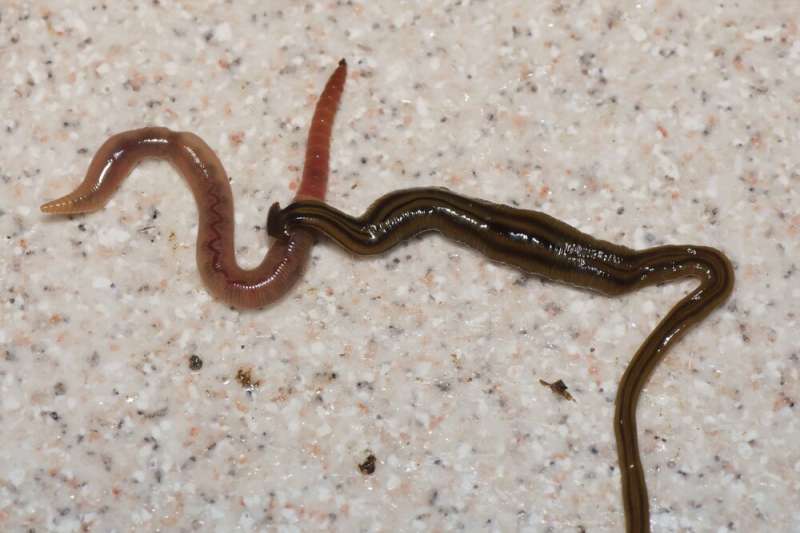
The little "hammerhead worm," Bipalium vagum
Bipalium vagum has the same general shape as Bipalium kewense, with its elongated body and broad head, but it is much smaller, a few centimeters long, and the lines on its back are much more distinct. The species and found in Bermuda. As with all Bipalium species, the region of origin is believed to be in Asia, but it is not known where exactly. In 2018 we showed that the species is also present in . It has also been found in Florida, South America and various countries in Asia. In English, the species is called the "mollusc-eating hammerhead worm" although its diet has not been studied in any specific way.
One of the "100 most harmful invasive species," Platydemus manokwari
In 2000, scientists drew up a list of the . This includes the tiger mosquito, the Florida turtle and the black rat. One land flatworm was included: Platydemus manokwari, the New Guinea flatworm. It eats snails and was in an attempt to control giant African land snails, themselves introduced as potential food. Instead, they became a pest, attacking and exterminating many of the native snails and endangering island biodiversity.
In 2019, we received some very bad news—reports indicated that Platydemus manokwari had arrived in . The species is already in other Caribbean islands such as and is on the way to invade Florida, Texas and Louisiana. No report has yet been received from Martinique, but unfortunately it is necessary to add "yet." It has also been found in .
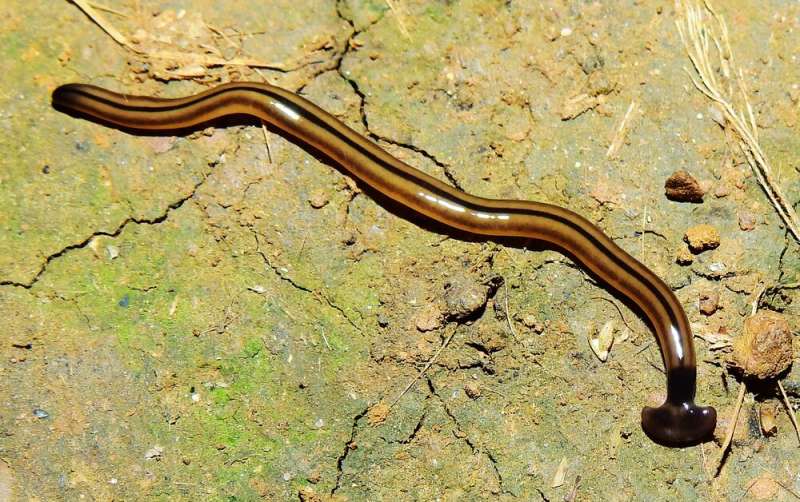
The one that looks a bit like a banana, Amaga expatria
Amaga expatria, like Bipalium vagum, was also from two specimens found in a botanical garden in Bermuda. No one has found this species for 15 years—one would think it is rare. And then, we received more than , 10 times more than all those that were known. Amaga expatria is well established almost everywhere on the two islands.
Amaga expatria is a large species, up to 15 cm long, with a broad and flat body. The color is yellow-orange, with black dots. Yes, it looks a bit like, in color and shape, a banana cut lengthwise.
Where does this species come from? The species name "expatria" had been chosen to indicate that it was not at home in Bermuda. The genus Amaga includes about 10 species from South America, and so the species probably comes from there—but the species Amaga expatria has not yet been found in its country of origin. Is the species in other islands in the West Indies? We do not know.
For Amaga expatria, we were able to use advanced molecular methods to analyze its , as we had done for . As a further result, new sequencing methods make it possible to identify the DNA of the animals the worm has eaten. This is how we had proof that Amaga expatria eats a snail in Martinique, named Subulina octona. Local naturalists have also told us that .
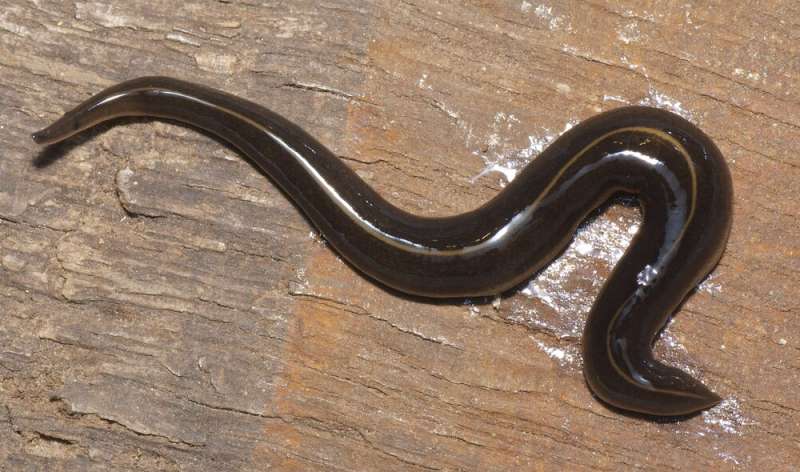
Where do these invasive worms come from?
Each of these species has a different geographic origin: Continental Asia for Bipalium kewense and Bipalium vagum, New Guinea for Platydemus manokwari, and Central America for Amaga expatria. How did they get to the West Indies? The answer is the same for all: by transporting plants. A land flatworm in the soil of a flower pot, or even stuck between two leaves in a banana plant, is virtually invisible. These worms to not invade the world alone and certainly not on purpose—it was international and inter-island trade that enabled their spread. Once on an island, they will invade very slowly, garden by garden, or very quickly, if flower pots or plants are transported. When the invasion happened, we don't know, but Bipalium kewense, for example, has been reported in .
Why is this important for the ecology of the West Indies?
All of these land flatworms are predators—they eat prey that they will capture on the ground. However, soil ecology is important, and depends on all those animals that live in the soil and on its surface. Adding new predators to the West Indian soil ecosystem, which will consume some species but not others, has the potential to upset ecological balances. It's like putting a wolf in a field of sheep—it's not hard to imagine that the number will decrease. But we do not yet have precise figures on the impact of these introduced species—what their prey is and how great the impact.
-
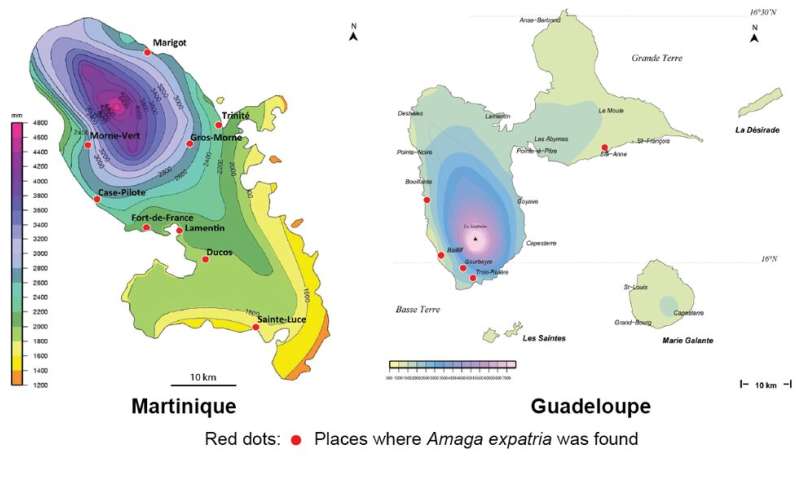
Places where the flatworm Amaga expatria was found in Guadeloupe and Martinique. The colours represent rainfall. Credit: Jessica Thévenot; background, Météo-France -
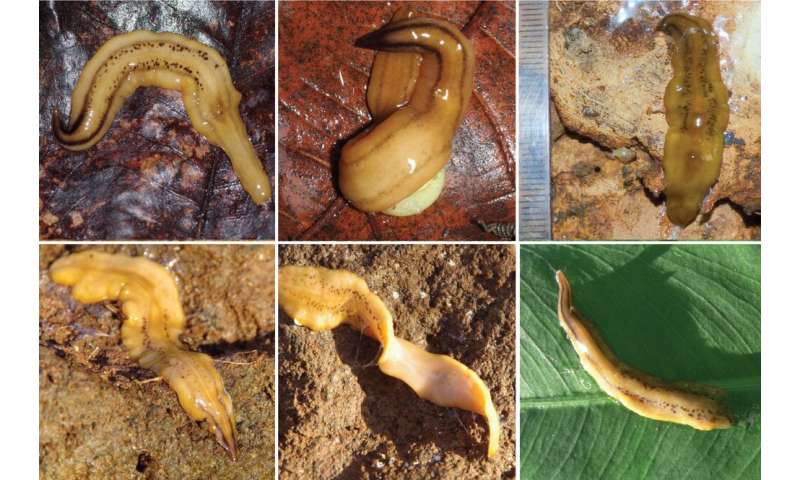
The flatworm Amaga expatria, living animals photographed in various places in Guadeloupe. Credit: Laurent Charles, Mathieu Coulis et Guy van Laere
What to do?
We currently are in the early stages of scientific work to find out what the ecological impact of these invading animals is—this is currently unknown. Eventually we would like to find ways to remove them, but this is a distant goal. Right now, you can help by found in your garden or on your walks. It's simple: take a photo, note the location, and . Who knows, there are probably other species not yet spotted—unfortunately.
Provided by The Conversation
This article is republished from under a Creative Commons license. Read the .![]()




















